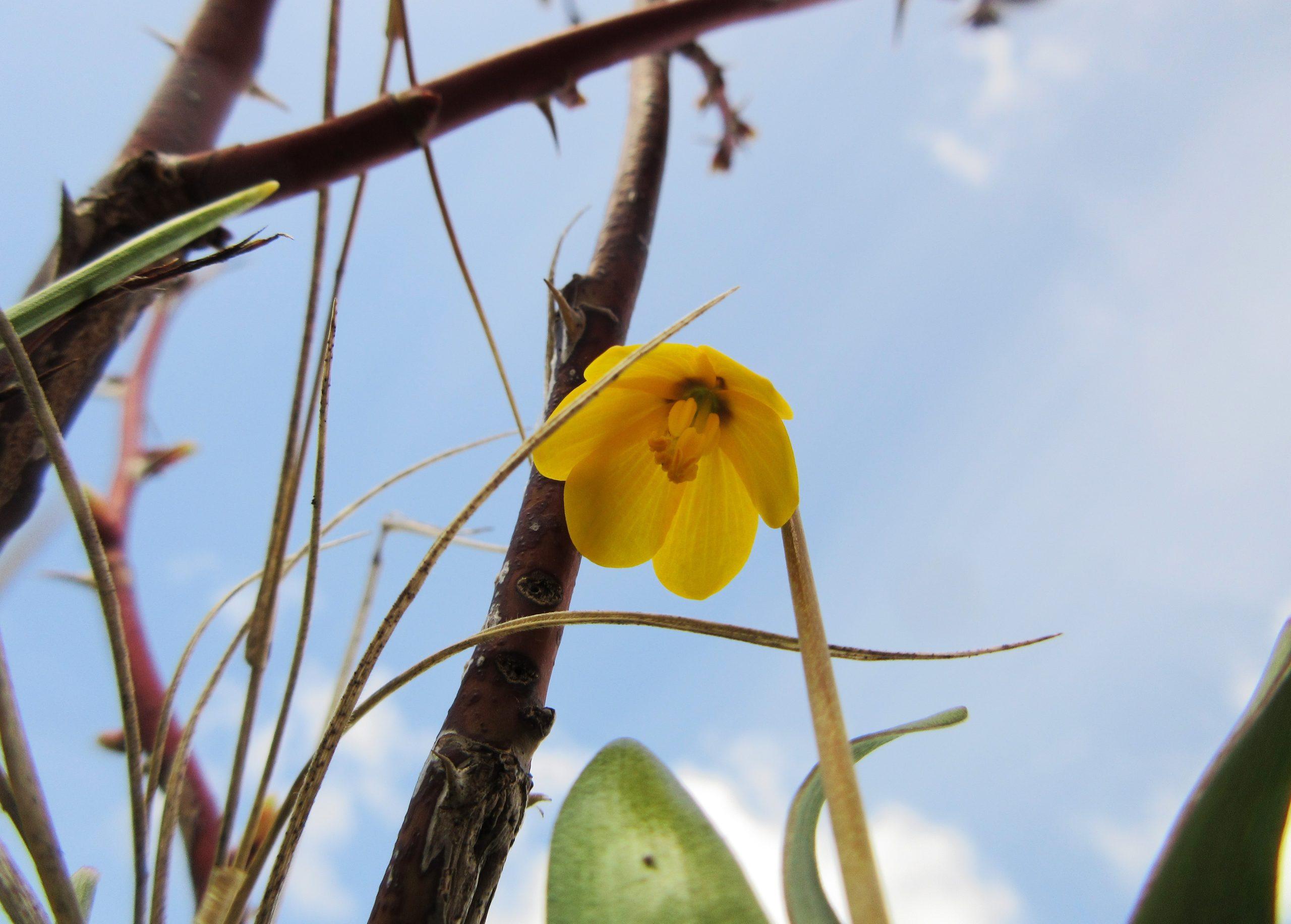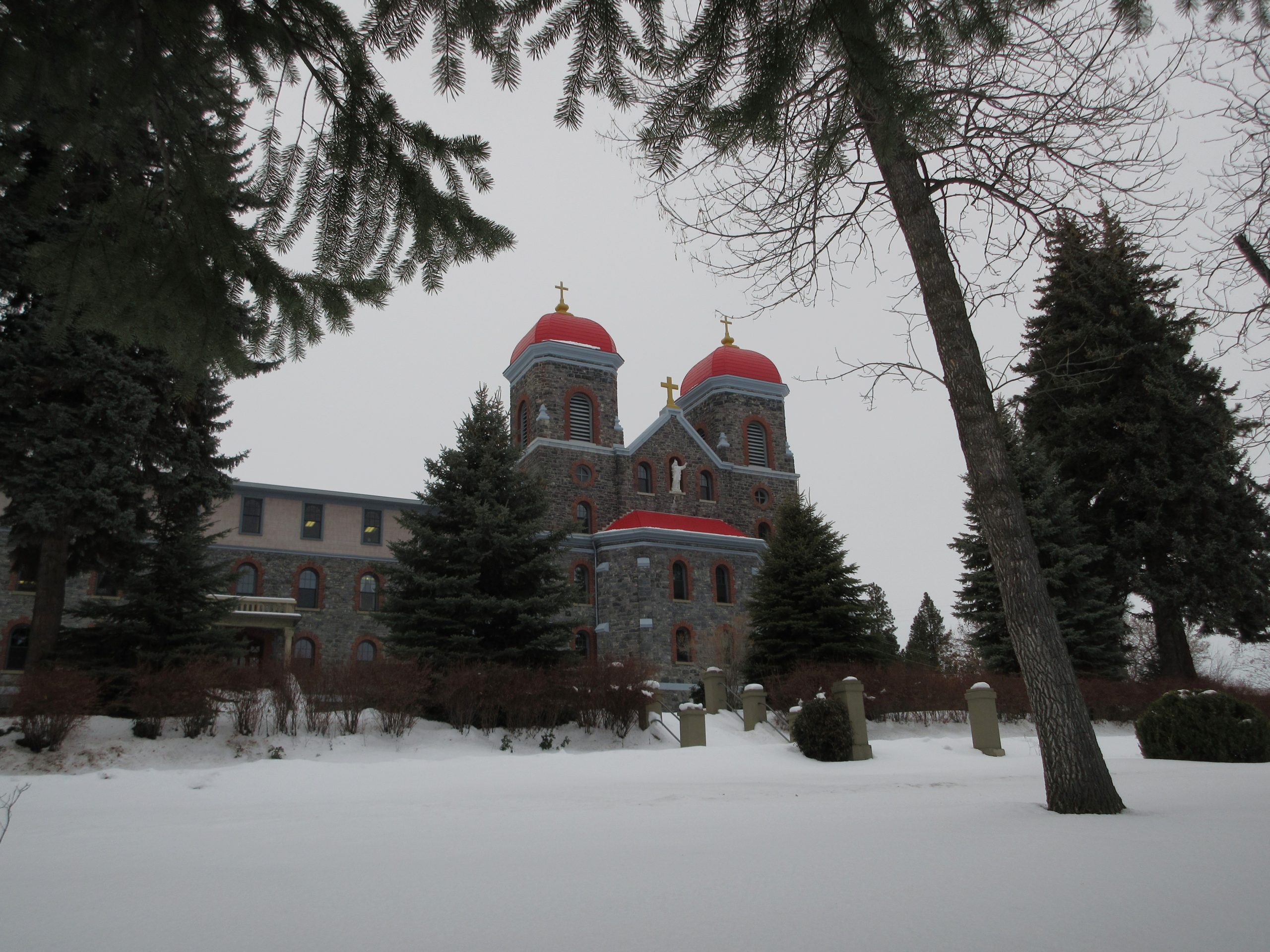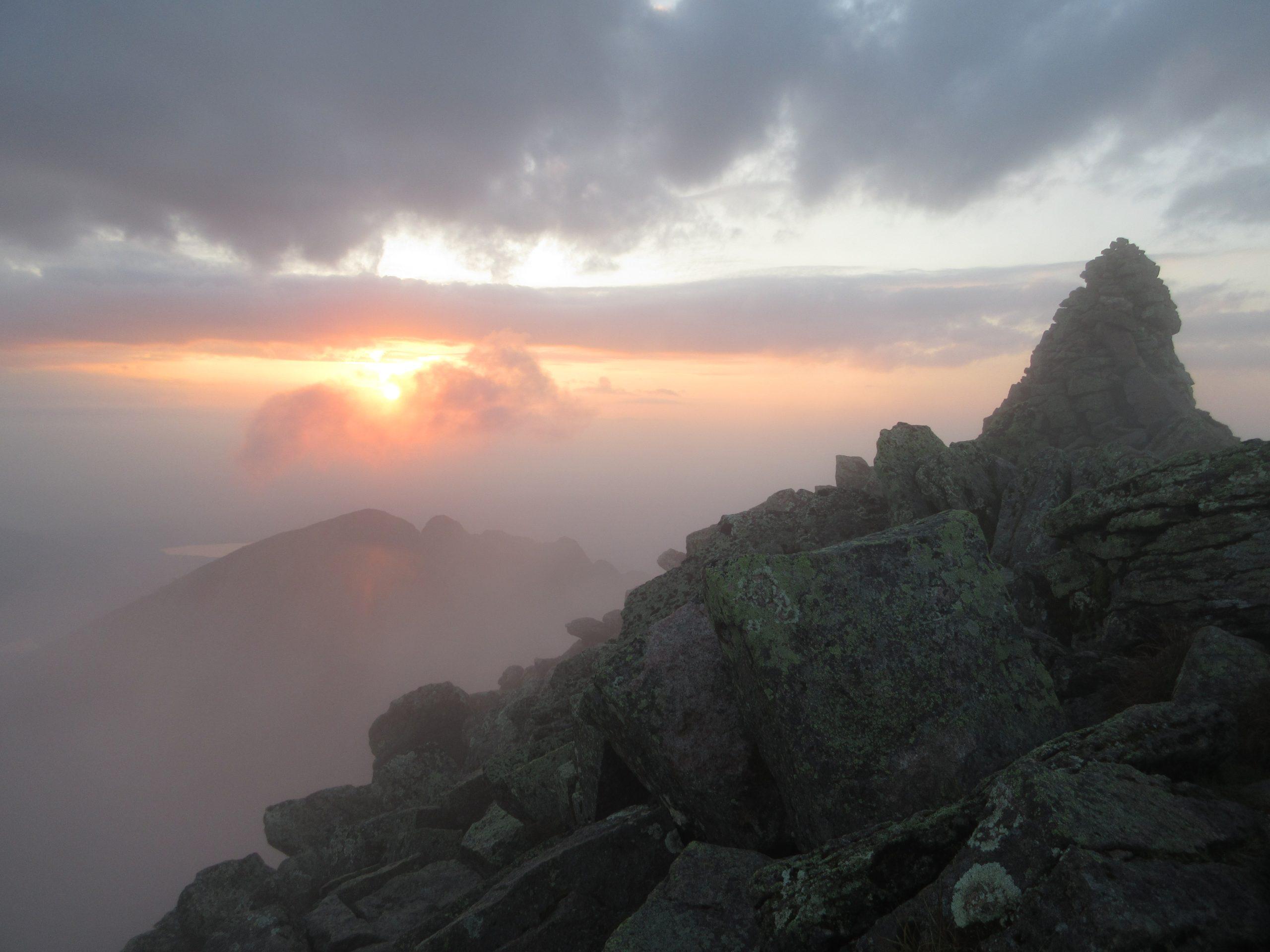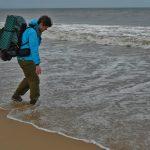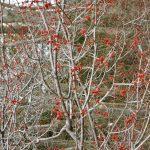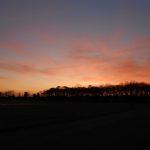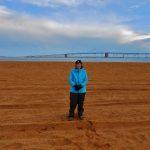Early-spring greetings! The winter has surely flown by. In the Maine Woods, one week past the Spring Equinox, there is still snow on the ground, and lakes remain solidly frozen. However, we’ve transitioned into what I call “maple syrup” weather. Daytime temperatures rise well into the thirties – sometimes even into the low forties – but nights drop back below freezing. Beneath the rough gray bark of maple trees, sweet sap is flowing. Sugarmakers are hard at work, collecting the sap in buckets or tubing and boiling it down into syrup.
Yesterday, March 26, was Maine Maple Sunday, when sugarhouses opened their doors to the public in an annual rite of spring. I visited Baker’s Maple Syrup in Shirley for what I think of as my “maple spa” treatment. I leaned over a tub of roiling sap, my face bathed in steam, deeply inhaling the warm, moist, maple-scented air. The intensity of the maple flavor changes over the course of sugaring season, starting out milder, becoming progressively stronger. My preferred grade of maple syrup, with a robust, earthy taste, will come a bit later. I put my order in for a gallon. I use it in squash and pork dishes, salad dressing, and cranberry sauce, as well as on pancakes.

This winter, I’ve posted a series of mini-essays on Facebook, chronicling my journey through the season. A faithful reader suggested I compile these posts into a blog entry. Some of my blog subscribers don’t have Facebook accounts, and my guess is that most of you who do haven’t seen all of my posts. So here is a recap of winter’s highlights.
I think of Christmas, which follows close upon the heels of the Winter Solstice, as the gateway to the new season. Daylight is extremely short, with less than nine hours from sunrise to sunset. In this era of climate warming, snow on the ground is often scant, and lakes have yet to freeze. For these reasons, conditions tend to be less than ideal for outdoor exploration. This is my time to savor domestic joys: the light and warmth of home, the fellowship of good friends and the wider community.
Two days before the holiday, small miracles of kindness eased my way through a stressful morning.

December 23: I’m pausing amid the bustle of last-minute Christmas preparations to give a shout-out to the joys of small-town life — or at least, small-town life in the Greenville/Shirley/Monson area of northern Maine. This morning I went out in a miserable icy-wet wintry mix, braving slippery roads from Monson to Greenville, because I had a hair appointment. After my cut, when I got back into my car, it wouldn’t start! (Groan. I had multiple errands to do today, and I was planning a drive of several hours tomorrow to join friends for their Christmas celebrations in Waterford.) I’d noticed a couple of slow starts recently and had been thinking I should get my battery checked when I went to get my oil changed in a few weeks; in retrospect, I shouldn’t have put it off. On this day before Christmas Eve, I was determined not to get upset, reassuring myself that all would work out. Porter’s Garage was a two-minute walk away. I thought I could wait in Union Church, just across the street, while the staff at Porter’s looked at my car – as an active volunteer, I have a church key. I reached into the compartment where I keep the ring that has both my church and my storage unit keys – and it was completely, utterly gone! This was really not good. Still determined to maintain my composure, I walked to Porter’s, getting pelted with ice pellets at every step. Rocky, who has worked on my Subaru before, came out to help me. He jump-started the car, then I drove into the garage and sat there while he extracted the old battery and dropped in a new one; I never even had to get out of the vehicle. (It turned out the old battery dated back to 2017; I didn’t know because I bought the car used in 2019.) It was a total of just 45-50 minutes from the moment I realized my battery was dead until I was back on the road. I decided to stop by the church and check the vestibule – and sure enough, my keys were there. Someone had found them and discreetly tucked them under an arrangement of Christmas greenery. On my way back to Monson, I stopped at the home of friends to drop off a card – and received a homemade ice cream pie in return. What could have been an awful day turned out to be unexpectedly heartwarming. I feel so blessed to live in such a wonderful community.
After celebrating Christmas with my friends, I parked at the Appalachian Mountain Club’s Medawisla Lodge on Second Roach Pond, and snowshoed 3+ miles to my cabin on First Roach, gear sled in tow. I rang in 2023 in the golden glow of lamp- and candlelight and the cozy warmth of my trusty woodstove.

After the holidays, I returned to my rental in Monson, where I work as manager of the Appalachian Trail Conservancy’s Visitor Center during the summer and fall hiking season. As the New Year began, I was looking forward to January’s snows and the prolonged deep cold that would freeze lakes and ponds. But they were slow in arriving. Instead, we experienced uncharacteristically warm temperatures. Thaws and rain eroded what little snow we had on the ground, yielding a premature mud season – another sign of our warming climate. In mid-January, in a long stretch of mostly gray weather, I took comfort in the unexpected gift of a flamboyant sunset.

As the month wore on, each new snowfall was a cause for rejoicing.

Wintry water (January 21): I strapped my microspikes onto my boots and headed out to Tobey Falls, on Big Wilson Stream in Willimantic. Roiling water tumbled over slate ledges, between banks coated in a fresh layer of white. The harsh music of water cascading over rock carried far through the cold, still forest.

White plain (January 27): Moosehead Lake has been slow to freeze this winter. But over the past few weeks, its surface has transformed into a vast, 118-square-mile ice sheet. This afternoon, in the sunshine following a storm, I headed to Lily Bay State Park, strapped on my snowshoes, and set out to explore. The ice has not yet thickened to the point where I would venture far from the safety of solid ground, so I stayed close to the woods along the shore. The storm delivered several inches of new snow. With each step, I crunched through icy crust into a layer of softer snow beneath. I was not the only one who had passed this way. Cloven hoofprints marked the path of deer. Birds were out and about; I heard the nuthatch’s nasal honk and a few “chickadee-dee-dees” coming from the trees. A light breeze sighed through the boughs of spruce, fir, cedar, and pine. Above the green branches, the sky was stunningly blue. But not all the local creatures could see the brightness of the day. For those who live below the ice, freeze-up is the start of a long, dark night. For trout and salmon swimming in the lake’s cold depths, and beaver families huddled in their icebound lodges, their next glimpse of daylight will come with the spring.
After a warm January, February began with temperatures plunging perilously low.
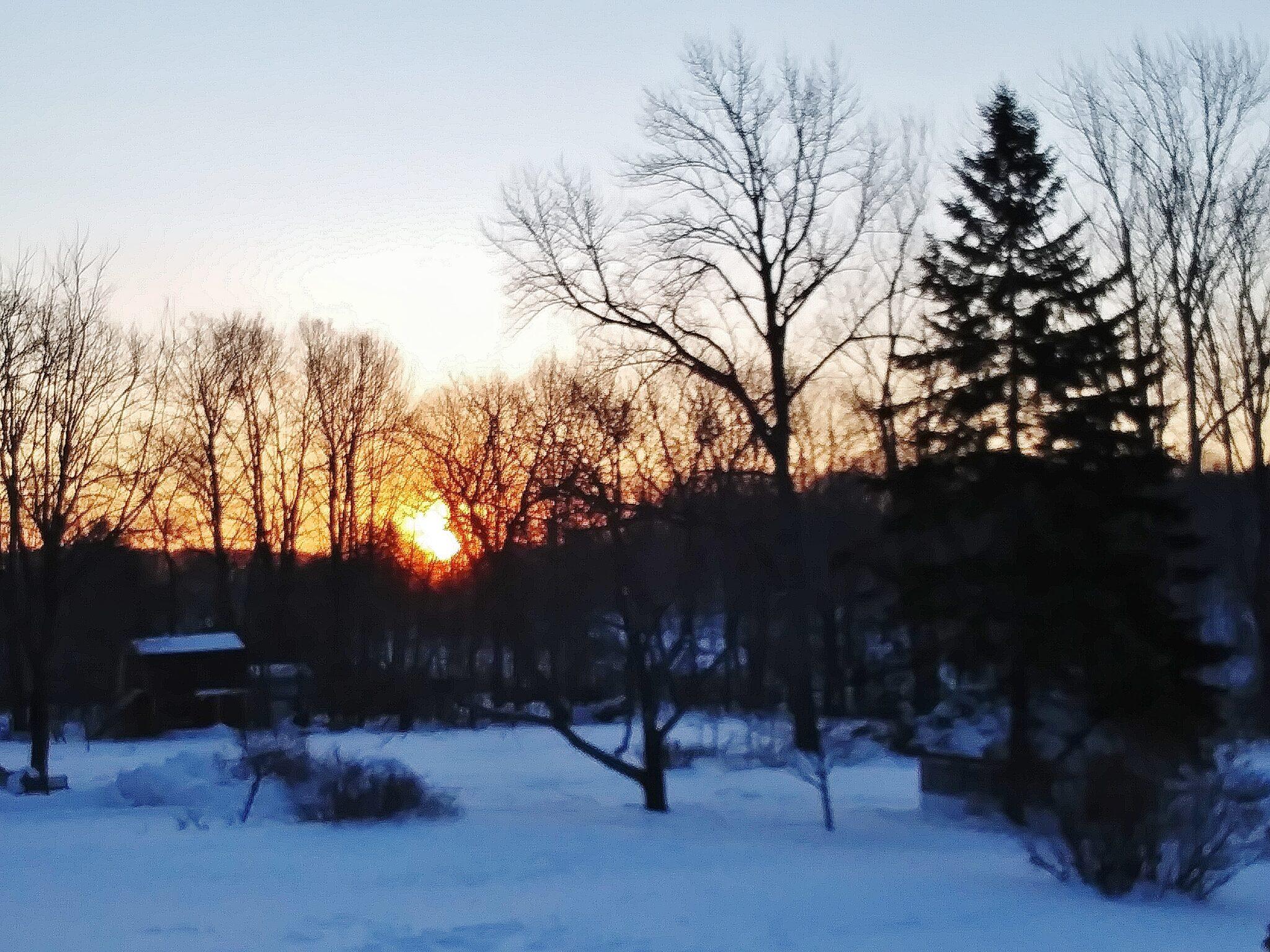
Arctic dawn (February 4): The coldest days are often bright and sunny. I’m riding out the polar vortex in safety, if not total comfort, in my rental in Monson. Yesterday, as the temperature plummeted, my bathroom pipes, which run close to the roof, froze. The furnace struggled to keep up with the cold and the wind. I decided to make my bed on a downstairs couch, where it was relatively warm; even there, the temperature was creeping downward through the fifties. While I slept, the power went out for a while, shutting the furnace off entirely. When I awoke, it was just 48 in my temporary bedroom – but the sunrise was lovely!
I suited up to walk down the street to the Monson General Store for breakfast. The temperature was around minus 20 and the wind, according to Ventusky, was gusting to about 60 miles per hour. The closest National Weather Service station, in the nearby town of Greenville, was reporting a wind chill of minus 56. The General Store was blissfully warm, so I lingered over a cup of hot tea with a cinnamon scone. Afterwards, I made a brief foray onto the frozen surface of Lake Hebron. As I ventured out on the ice, the fierce wind pelted my face with blowing snow. It couldn’t have been more than a couple of minutes before I felt my cheeks going numb. I turned around for a warm-up at the store before my short walk home.
Ironically, I would probably have been much more comfortable in my off-the-grid cabin, basking in the glow of the woodstove, than I was in a house in town. That being said, I realize it’s not safe to be all alone in the woods – with only tenuous communication with the outside world, and miles from the nearest neighbor – in such extreme cold. In case of emergency, walking out to get help would not be a realistic option for me. It wouldn’t be just my personal safety at risk, but the safety of any first responders who might be summoned. Cold this intense is implacable; the strongest human is fragile in its grip.
After making it through the vortex, I was eager to get out and explore the winter woods.
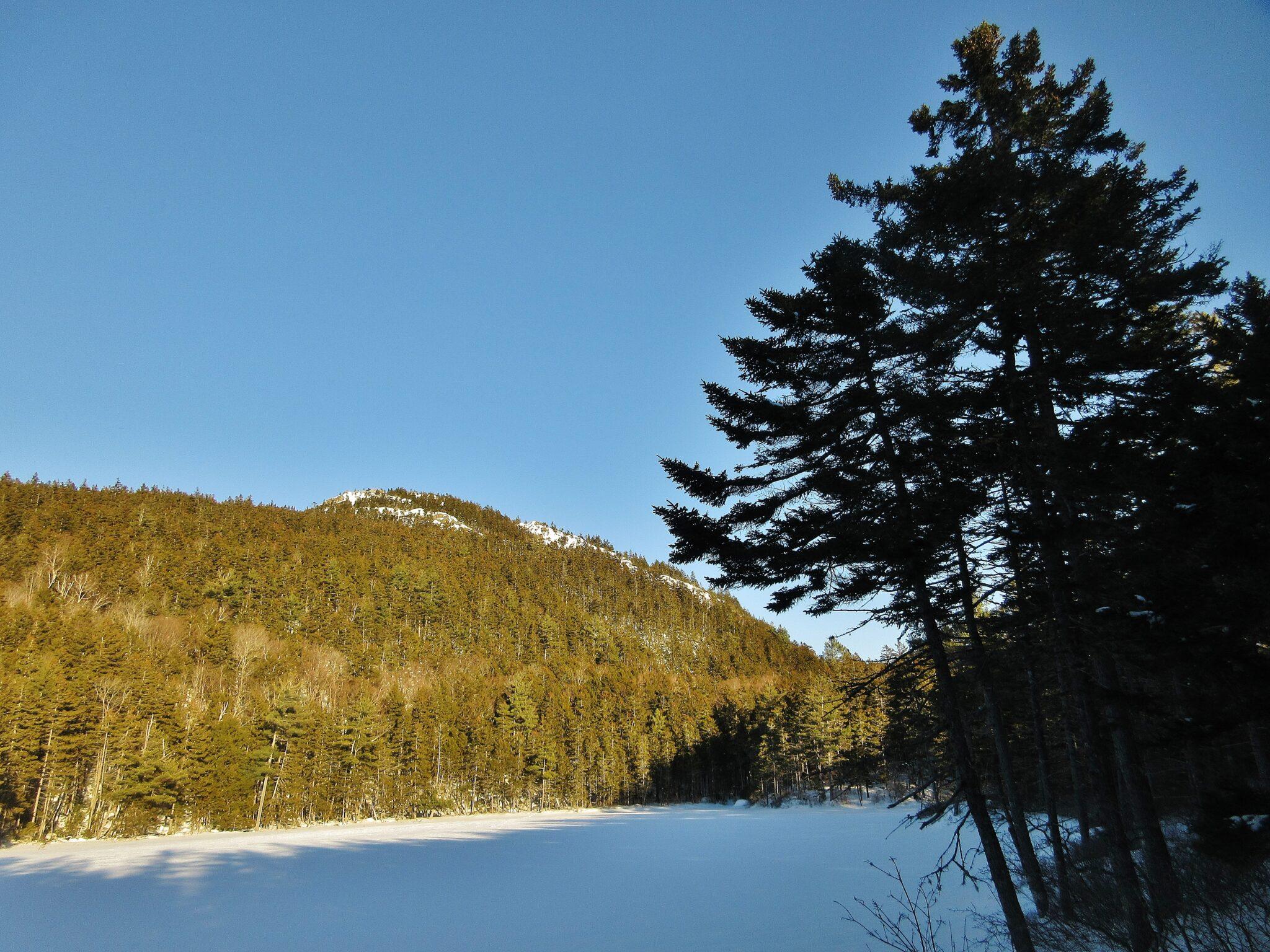
Elusive summit (February 11): This morning, the lovely winter world outside my windows called to me, offering sunshine and new-fallen snow. How could I resist? So I headed to Borestone Mountain Audubon Sanctuary in Elliottsville. I parked near the gate, strapped on my snowshoes, and broke trail up an old gravel road to Sunrise Pond, shown here, with Borestone’s West Peak rising above the opposite shore.
Along the way, nature’s music played overhead. Wind sighed through the branches of spruce and hemlock. Now and then, I heard the voices of hardy birds: a raven’s croak, the insistent calling of a nuthatch, the twittering of chickadees. I paused by the pond for a picnic lunch with a comforting flask of hot tea. Then I continued up the steeper summit trail, digging into the fresh snow with the crampons under the balls of my feet to keep from backsliding.
When I reached the base of the summit dome – where the trail grows even steeper, climbing sharply upward over bare boulders – I traded my snowshoes for microspikes, which provide better traction on rocky surfaces. I wasn’t sure if I could safely reach the top. I’ve made it up to Borestone’s West Peak at least six times in the winter, but I turned back on one previous attempt because conditions were too icy.
It was clear that no one else had been this high on the mountain for at least a few days. There were no remaining tracks to mark where earlier hikers had found their footing. I moved slowly and cautiously. I soon realized the new snow concealed sizable areas where thick ice coated the rocks. I tested three possible routes up the first pitch, keeping an eye on where I would slide if I lost my footing, avoiding spots that appeared too risky.
After about forty-five minutes, I reluctantly concluded that continuing the climb was not a reasonable option. If I had mountaineering crampons, or companions to help with scouting routes and boosting or pulling to get past the slickest spots, the situation might have been different. So I sat down in the snow, pushed off, and slid back down the slope to where I had parked my snowshoes. I thought longingly of the snowcapped summit, with its sweeping views across frozen Lake Onawa toward Barren Mountain. Today it would remain untrodden, the views unseen, except perhaps by a passing raven.
Forgoing the summit meant that I had extra time and energy to burn, so I followed a more circuitous route back to my car. As always happens in the woods, I found gifts to console me for the loss of my intended goal. As I crossed the ice of Sunrise Pond, my nostrils detected a whiff of skunk-like odor. An odd gift, you might say – but it signaled to me that foxes are seeking mates in anticipation of the coming spring. And my hike ended with views of a sunset sky of glowing apricot melting upward into lavender.
In late January, I had signed on as a substitute teacher in the Greenville school. I knew I wouldn’t be called in to teach during school vacation (the week of February 20), so I seized the opportunity to head “upta camp.”

Cabin in the Cosmos (February 22): Two days ago, I loaded food, clothing, books, and laptop into my gear sled at the public boat launch on the south shore of First Roach Pond. I strapped on my snowshoes, buckled the sled’s harness around my waist, and headed for my off-grid cabin on the peninsula between First Roach and its North Inlet – a trek of about two and a third miles across the ice.
What a joy to be home! I packed trails in the snow to my pump and outhouse, pumped and hauled water to fill various storage containers, then got a roaring blaze going in my woodstove. I spent the evening basking in the fire’s glow.
Yesterday morning, I awoke to a glorious, sunny day. A vibrant blue sky arched over a dazzlingly white world. Somehow, in winter, the sky seems bigger to me, dwarfing the woods and waters beneath.
As sunset approached, clouds began to move in. I wandered along my shore, keeping an eye on the orange and gold horizon as I followed the tracks of a trotting fox. I could guess what was on the creature’s mind. Earlier in the day, I caught hints of the skunk-like scent through which a male fox announces he is ready to mate. I noted how far north the sun has journeyed since the December Solstice. The winter is flying by; the Spring Equinox is less than four weeks away.
I turned back to my cabin to bring in wood for the night ahead. About an hour later, I returned briefly to my shore. I must confess it was for a mundane purpose. I needed to check my phone for a text, and I’ve found a tenuous signal there. But every trip outside offers its natural rewards. I caught a glimpse of a slender sliver of a waxing crescent moon sinking in the west.
I hoped, after moonset, to do some stargazing. I especially longed for a view of the Big Dipper above my cabin. The clouds to the north did not seem promising, but I decided to give it a try anyway. So, a bit later, back out I went – and discovered the clouds had temporarily cleared. The black sky was spangled with stars that glittered between the bare branches of maples above my head. There was the Dipper, hanging like a big question mark in the northern sky.
I stood watching for several minutes, immersed in the night. The ice on the pond made intermittent sounds I would describe as something between a boom and a gurgle. A light breeze arose and sighed through the trees. The Dipper’s “handle” was pointing directly toward my cabin roof. I gasped in delight when, suddenly, a shooting star flashed across it. The sight felt like a gift meant just for me.
When the calendar turns to March, I’m always a bit stunned. How can the season be passing so quickly? Late-winter snowstorms feel bittersweet.
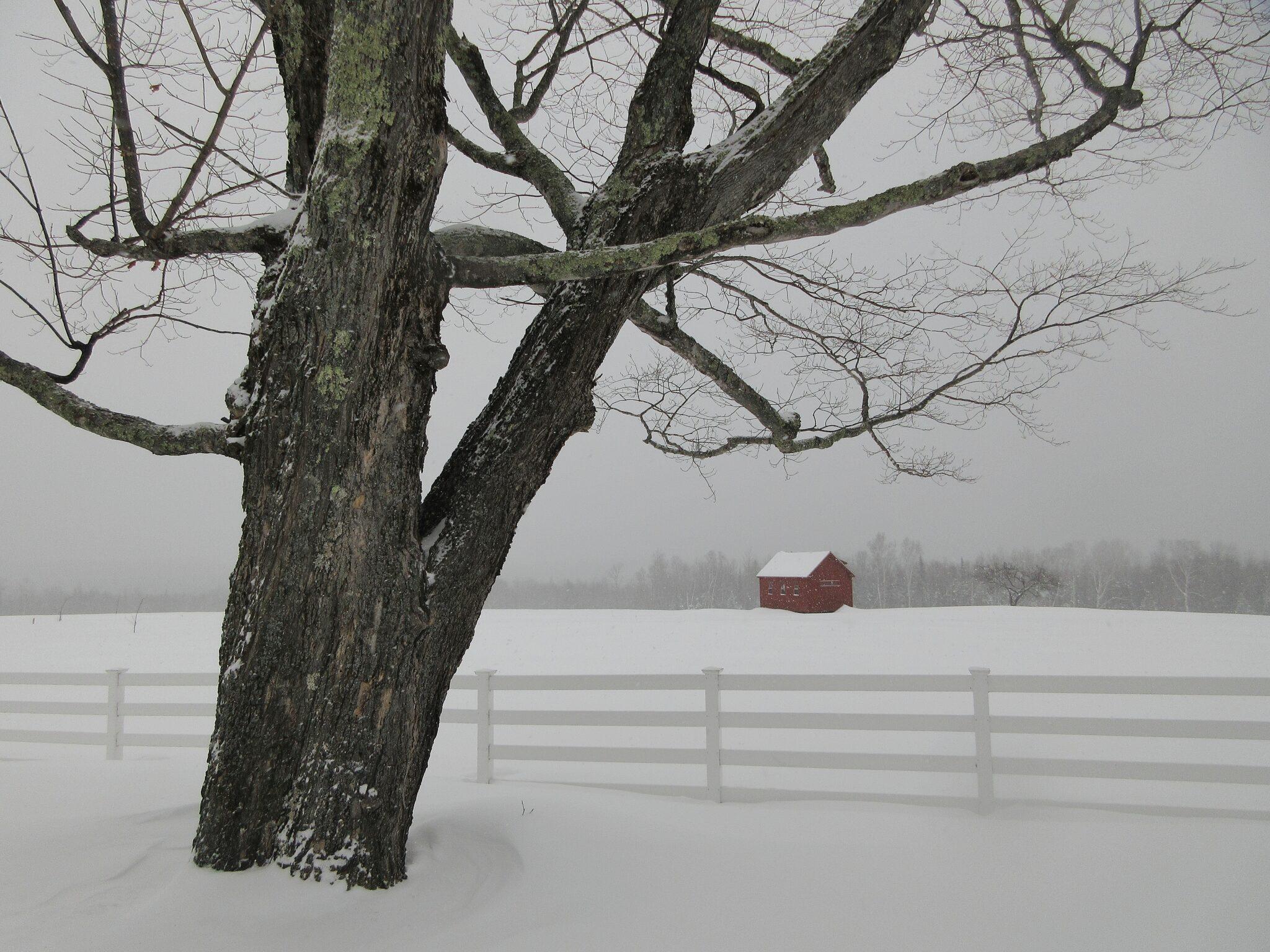
March 4: This morning, I paused along the North Guilford Road to enjoy the gentle beauty of falling snow. I stood by an old, lichen-encrusted sugar maple, gazing across a field toward mountains that had disappeared into a gray void. A chilly northeast breeze brushed my face and sighed past my ears. It peppered me with granules of snow that melted on my cheeks and tapped against my jacket. Behind me, last year’s beech leaves rustled, brown and dry, still clinging tenaciously to their parent branches. Snowmobiles roared faintly in the distance.
This is the time of year when I start to mourn winter’s passing. The Spring Equinox is less than three weeks away. I know that, in due course, I will rejoice in the return of songbirds in April, and in the unfurling of tender new leaves on the trees in May. But for now, I’m still savoring winter, and I’m grateful for our remaining weeks of snowy woods and frozen ponds.
In early March, I feel a sense of urgency, knowing I have only a few more weeks for snowshoe adventures. It’s time to get out and visit favorite winter spots before mud season closes the trails.
Icy plunge (March 6): Today, I hiked to Moxie Falls. I stood in rich evergreen woods of hemlock, pine, cedar, spruce and fir, at the edge of a deep gash cut in the forest floor by Moxie Stream. Water poured in a resounding torrent over a sandstone ledge, plunging ninety feet behind a veil of ice into a clear brown pool below. I could see that humans are not the only creatures who enjoy this spot. Troughs in the snow alongside the falls revealed paths where otters slide down on their bellies. How I would love to watch an otter in the act, his sleek brown body whizzing exuberantly down the slope, carefree in the knowledge that wherever he landed – in snow or water – he would be in his element.

Walking on water (March 11): I set out across the ice of Moosehead Lake from the village of Rockwood toward Kineo, which looms above the opposite shore. In Wabanaki lore, Kineo is the body of a moose killed by Penobscot culture hero Gluscape. He shot the moose with an arrowhead made from rhyolite – a flint-like volcanic rock – and the animal’s carcass transformed into a mass of the same stone. For millennia, indigenous people traveled to Kineo to quarry this rock for making tools and weapons. To me, the mountain looks like a basking lizard: looking from right to left, I see its head, shoulders, rump, and tail.
It was a perfect late-winter day, sunny and relatively warm. All of us who love the season are keenly aware the end is drawing near. And so the ice was dotted with revelers: fishermen with pop-up tents or more substantial shacks of wood or metal; snowmobilers; even a small plane.
I ascended Kineo into a quieter realm, sheltered by trees that grow from a thin layer of soil atop the bedrock. At the summit, I climbed the tower that rises above the canopy. I stood on my solitary perch under the blue and white dome of the sky. I looked down on the bright white expanse of Moosehead, sprinkled with islands and ringed by forest in wintry shades of dark green, gray, and brown. The land, stretching toward the horizon in all directions, rose in waves of mountains.
I reluctantly returned to Earth and headed back down the trail to the lake, crossing the ice to my car as the sun was setting. The colors were somewhat subdued, but lovely nonetheless; my eyes were drawn by a soft pink glow in the southeastern sky.
Soon, spring will arrive, and I will lose my seasonal power of walking on frozen water. I’m grateful I was able to seize this glorious day.
Two days ago, on March 25, I paused on the deck of my rental in Monson. I was getting ready to snowshoe across still-frozen Lake Hebron, thinking this might be my last chance before warming weather destabilizes the ice. Suddenly, my ears caught a distinctive harsh trill: a red-winged blackbird! The sound evoked an inner flash of welcome and joyful anticipation. Red-wings are among the first birds to return from the south, vanguards of a vast tide of winged migration. Though I will miss winter, I will surely find consolation in the songs of spring.


